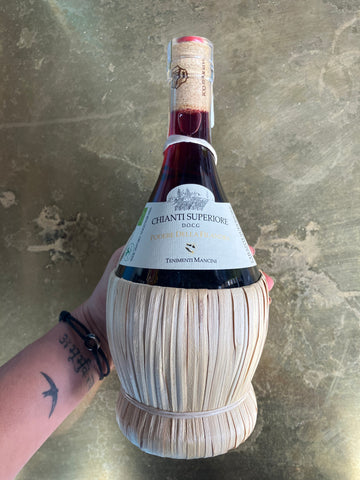
Chianti Masterclass. Straight to the Heart of Tuscany.

The longer nights have drawn in and so too has the miserable weather. Gone are the days of glasses of a light Rosato and Pesce Crudo.
What we all need are warming glasses of red wine and hearty dishes such as Pasta al Ragù and Bistecca alla Fiorentina. And what other wine is more fitting than Chianti?
Its savoury, earthy character aligns with the changing seasons and the onset of Autumn, while it has enough depth both accompany those autumnal dishes or to simply drink over the course of an evening.
No wonder then, that this was the first option that came to mind when Luca was choosing what to focus on for the November Box of the Month…. A Chianti Masterclass was the way to go.

First things first. There are a few things that need to be said to set the record straight about Chianti.
A blanket term used to refer to all wines produced in the Chianti region that encompasses Florence, Siena and Arezzo, the winemaking history of this area stretches back millennia. It was not, however, until 1716 that further specification was imposed by Cosimo III de’ Medici to delineate the territory. In subsequent centuries additional legislation has included the status of Chianti Classico DOCG that requires for the wine to be composed of at least 80% Sangiovese and the introduction of the Chianti Classico Gran Selezione. And last but not least: the Black Rooster. A symbol dating back to the Middle Ages and which is now used to designate a wine produced within the territory of Chianti Classico.
Chianti is undergoing a resurgence in popularity and public opinion. And that is long overdue. In the 1980s the wine was almost relegated to the realm of kitsch Italian restaurants with checked tablecloths, Spaghetti Bolognese and balloon shaped bottles of wine.
But those specific type of bottles known as Fiaschi used for Chianti had become disassociated from their heritage.
These round bottomed bottles were first mentioned by Boccaccio in the Decameron circa 1350 with the now ubiquitous straw basket being introduced slightly later so that the bottle could stand up and did not have to be emptied in one go. The Fiasco is thankfully making a comeback as in the case of Buccia Nera’s Fiasco and we are not complaining.

Of course, there are many excellent Chiantis out there, with estates that date back centuries and others that have achieved widespread recognition. One case in point is Castello di Monsanto: founded in 1961 in an eighteenth century castle and with the philosophy of merging the past with the future. Over six decades they have played a key role in the recognition of Sangiovese being the first Chianti Classico to name Cru on the Riserva label in 1969. As their traditional labels might suggest, these are classic wines that deserve time. At a recent hedonistic dinner at Scott’s, vintages from 1969, 1978, 1980, 1982 and 2004 demonstrated that these wines are capable of ageing forever.

And then there are increasingly more producers experimenting with new methods such as fermenting in concrete tanks rather than the traditional wooden barrels. But, for us to want to jump on a plane to go and visit the estate, there are a few criteria that need to be met… Firstly, are they working sustainably and with low intervention philosophies? Is there something about the wines that captures our imagination?
Take Buccia Nera. As much as this is about their Chianti, it was the changes that progressiveness of their wines that really piqued the interest. With a dedication to organic and natural wines, wines such as their Confondo Pet Nat and PA’RO orange with a voluptuous nude woman on the label are not what you would expect of a traditional Tuscan estate. Yet, the wine that they produce under the name Podere della Filandra is a strong nod to tradition. These are hearty and full wines with strong red berry fragrances. These are the sort of wines you want to wash down a Bistecca at a lively (bordering on rowdy) lunch and that is the sweet spot they hit, especially with bottled in fiaschi.
It is a slightly different story with Carpineta Fontalpino. Romanticism rules here. Set on land fought over in 1240 by the Florentines and the Sienese, its name comes from the silver backed trees of the local area known as Carpini and the nearby natural water source of Fontalpino. Run by siblings Gioia (the oenologist) and Filippo, the wines are a reflection of the history of this terroir. Pure and elegant, their wines are a reflection of the different soils that their estate covers, as in the case of their Montaperto for which the vines are grown on a soil enriched by a rare type of rock known as Galestro.
And so, these three producers – Buccia Nera, Castello di Monsanto and Carpineta Fontalpino – demonstrate how Chianti is not simply Chianti. There is a world of difference in the impact of the terroir and winemaking practises not to mention the different traditions that typify Chianti wines from different areas of Tuscany.
Yet perhaps what we love best is that these three estates are run by women; women who show how Chianti is not just a wine to wash down Bistecca alla Fiorentina, but one to be savoured, to be understood and to be appreciated.
